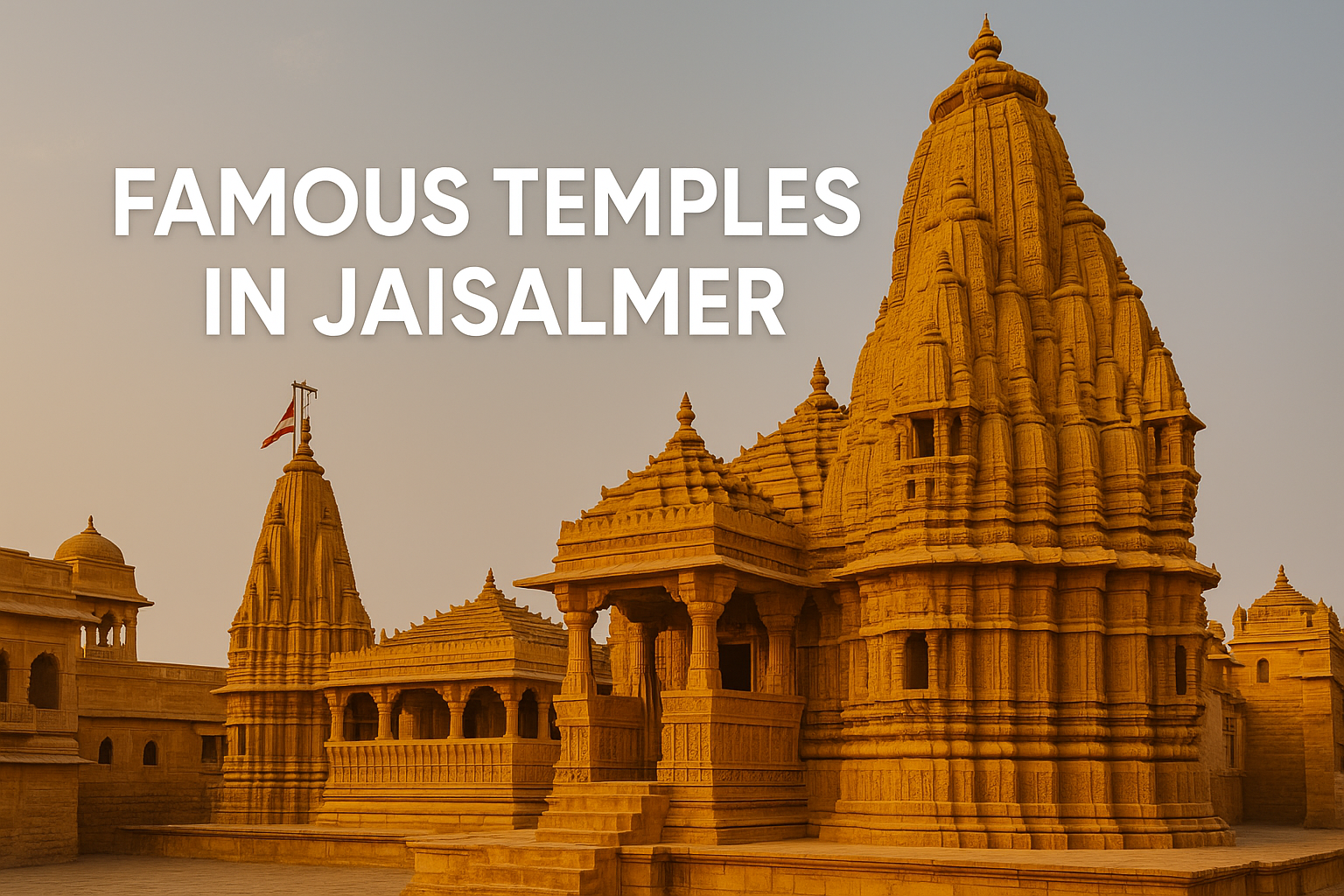Table of Contents

Famous Temple in Jaisalmer
Jaisalmer – The Golden City of India – is not just famous for its grand forts and desert views. It also has a deep spiritual side. Across the city and inside the ancient fort, you’ll find beautiful temples that have stood for centuries. These temples show the city’s rich history, devotion, and artistic beauty.
Whether you’re looking for peace, interested in culture, or love exploring heritage sites, Jaisalmer’s temples offer a calm and meaningful experience. Their stunning carvings, peaceful atmosphere, and unique designs make them a must-visit part of your journey.
Here’s a simple guide to 10 amazing temples in Jaisalmer you should definitely explore:
1. Jain Temples – Inside Jaisalmer Fort
Located within the majestic walls of Jaisalmer Fort, the Jain Temples are a remarkable group of seven shrines built between the 12th and 16th centuries. These temples are dedicated to various Jain Tirthankaras, including Rishabhdev, Shantinath, Parshvanath, and Sambhavnath. Crafted from golden-yellow sandstone, the temples are a masterpiece of Dilwara-style architecture, featuring incredibly detailed carvings on every surface—walls, ceilings, pillars, and domes.
The interiors are filled with sculptures of gods, celestial dancers, and mythological figures. Despite their modest size, the temples feel grand due to their intricate design and peaceful aura. The highlight is the Chandraprabhu Temple, which is the oldest in the complex and admired for its symmetry and stone latticework.
A small library, known as Gyan Bhandar, holds rare palm-leaf manuscripts and ancient texts in Sanskrit and Prakrit. These temples are actively used for worship and maintained by the local Jain community. Visitors should dress modestly and remove their shoes before entering. Early mornings are the best time to visit, as the fort is quieter and the golden morning light enhances the beauty of the temples.
2. Tanot Mata Temple
Situated approximately 120 kilometers from Jaisalmer, near the India-Pakistan border, Tanot Mata Temple is a symbol of faith, resilience, and divine protection. Dedicated to Goddess Tanot, a form of Hinglaj Mata, the temple gained national fame during the 1965 Indo-Pak war, when several bombs dropped near the temple failed to explode—an incident attributed by locals and soldiers to divine intervention.
Maintained today by the Border Security Force (BSF), the temple houses a display of the unexploded bombs as testimony to the miracle. Soldiers posted nearby often visit and protect the temple, and it remains an important spiritual site for both the locals and military personnel.
Besides its religious significance, Tanot Mata Temple is also known for its peaceful desert surroundings. Many travelers combine their visit with a trip to Longewala, the historic war site. The drive from Jaisalmer to Tanot is a unique experience in itself, offering expansive views of sand dunes, remote villages, and desert wildlife.
Visitors are advised to carry valid identification, as the temple lies close to a sensitive border area. A visit here is a profound mix of spirituality, patriotism, and desert adventure.
3. Laxminath Temple – Jaisalmer Fort
Nestled within Jaisalmer Fort, Laxminath Temple is one of the oldest and most revered Hindu temples in the city. Dedicated to Lord Vishnu and Goddess Lakshmi, the temple was constructed in the 14th century by Rao Lunkaran and represents the spiritual heart of the fort’s Hindu community.
Though not as architecturally elaborate as the neighboring Jain temples, Laxminath Temple carries deep cultural and religious significance. The structure features a simple yet elegant design, with a sanctum housing the idols and beautifully adorned inner sanctum walls. Regular aarti and religious rituals are performed here, creating a serene and spiritual atmosphere that contrasts with the bustling lanes outside.
The temple becomes especially vibrant during Hindu festivals like Diwali, Navratri, and Janmashtami, when it’s decorated with lights, marigolds, and incense. The chants and devotional music that echo through the temple complex offer a truly immersive experience of local faith.
Tourists visiting Jaisalmer Fort are encouraged to stop by this temple, not just for religious purposes, but to witness living history and the role of traditional worship in the city’s culture. It also offers a unique perspective on how Jaisalmer has been a melting pot of different religions and traditions
4. Shree Ramdevra Temple (Ramdevji Temple)
Located in Ramdevra village, around 150 km from Jaisalmer, this temple is a sacred site for followers of Baba Ramdevji, a revered local saint believed to be an incarnation of Lord Krishna. What makes Ramdevra Temple unique is its appeal across religious boundaries—both Hindus and Muslims worship here, making it a rare symbol of communal harmony.
Baba Ramdevji is celebrated for his spiritual teachings, healing powers, and compassion toward the poor and oppressed. Pilgrims from Rajasthan, Gujarat, and even across the border in Pakistan come here seeking blessings. The temple houses the saint’s samadhi (final resting place) and features a white marble structure with intricate carvings and a large prayer courtyard.
The Ramdevra Fair, held in August or September, draws thousands of devotees who travel by foot, sometimes covering hundreds of kilometers. Devotees offer wooden horses, a symbolic gesture of fulfilled wishes and gratitude.
The village atmosphere, spiritual energy, and cultural unity make visiting Ramdevra Temple a deeply moving experience. It’s not just a religious site—it’s a testament to faith that transcends boundaries, celebrating love and devotion beyond caste or creed.
5. Bada Bagh – Cenotaphs and Temple Shrines
Located about 6 km north of Jaisalmer, Bada Bagh is primarily known for its magnificent cenotaphs (chhatris) dedicated to the rulers of the Bhatti dynasty. However, scattered among these historic memorials are several small temple shrines, making Bada Bagh a subtle but meaningful spiritual site.
Each cenotaph is built in classic Rajasthani style—domed pavilions with carved sandstone columns and intricate jali (lattice) work. The temples, though modest, were once used by royal priests for rituals, offerings, and family prayers. These shrines highlight the spiritual life of the royal families and the sacred rites they followed.
Today, Bada Bagh is a quiet, atmospheric site, perfect for reflection and photography. The sunset views from the hilltop cenotaphs are breathtaking, as the golden light bathes the sandstone structures in a warm glow. It’s also one of the less commercialized sites near Jaisalmer, offering tranquility and a connection to Rajasthan’s royal and spiritual legacy.
6. Rishabhdev Raj Mandir – Amar Sagar
Located near the serene Amar Sagar Lake, about 6 kilometers from Jaisalmer, Rishabhdev Raj Mandir is a beautiful Jain temple dedicated to the first Tirthankara, Rishabhdev. This temple forms part of the Amar Sagar complex, which also includes a palace and other small shrines, all constructed in the signature golden-yellow sandstone of Jaisalmer. Built in the 18th century by Maharawal Akhai Singh, the temple is a blend of Jain spiritualism and Rajput architecture.
The temple’s design is intricate, with detailed carvings on pillars and walls, depicting deities, dancers, and floral motifs. The sanctum houses a white marble idol of Rishabhdev in a seated meditative pose, exuding peace and divinity. The complex offers a tranquil atmosphere, especially in the early morning or late evening hours when the lake reflects the golden tones of the temple.
Although smaller than the Jain temples inside the Jaisalmer Fort, Rishabhdev Mandir is equally rich in detail and less crowded, making it a quiet retreat for reflection and worship. It’s a spiritual gem tucked away in a scenic location, perfect for those exploring beyond the city’s core.
7. Shantinath Jain Temple – Lodurva
Located around 15 km from Jaisalmer in the historic town of Lodurva, the Shantinath Jain Temple is a beautiful example of ancient Jain architecture and devotion. Dedicated to the 16th Tirthankara, Shantinath, the temple is renowned for its delicate sandstone carvings, ornate pillars, and the iconic toran (arched gateway) that greets visitors. Lodurva was once the capital of the Bhati Rajputs, and this temple is a lasting reminder of its religious and cultural importance.
The temple complex is crafted from golden-yellow sandstone, and its intricate jali work allows sunlight to filter through in mesmerizing patterns. One of the most striking features is the Kalpavriksha sculpture—a symbolic wish-fulfilling tree carved from stone. Despite being located in a semi-ruined town, the temple is well-maintained and remains a site of active worship.
Pilgrims and tourists alike visit to admire the architecture and experience the spiritual calm. Early morning visits are ideal, offering solitude and a glimpse into the religious practices of the local Jain community. The site is also part of the Rajasthan Tourism heritage circuit, making it a must-visit for cultural travelers.
8. Surya (Sun) Temple – Jaisalmer Fort
Tucked within the ancient lanes of Jaisalmer Fort, the Surya Temple is a lesser-known gem dedicated to the Sun God. Though modest in size, it holds immense spiritual significance and architectural charm. Built from the same golden sandstone that characterizes the fort, the temple is known for its exquisite carvings depicting solar deities and traditional Rajasthani motifs.
Located close to the Jain temples, the Surya Temple is often overlooked, yet it offers a peaceful break from the more crowded spots. Devotees come here in the early hours of the morning to offer prayers as the first rays of sunlight hit the fort—an experience that enhances the symbolism of sun worship. The temple has a small courtyard, delicately sculpted ceilings, and a sanctum housing a symbolic idol of Surya riding his chariot.
The simplicity of the space adds to its sanctity, and the soft morning light filtering through its carved windows creates a divine ambiance. It’s a short but meaningful stop for those exploring the fort and interested in the diversity of faiths that have thrived in Jaisalmer over centuries
9. Shiv Temple – Chandan Fort (Kuldhara Road)
Situated near the ruins of Chandan Fort, just off the road to the abandoned village of Kuldhara, lies a humble yet spiritually significant Shiv Temple. Though not grand in scale, this temple holds deep reverence among locals and is especially sacred during Mahashivratri, when devotees gather here for night-long worship and celebrations.
Surrounded by sparse desert landscapes and ancient ruins, the temple exudes a raw, mystical energy that resonates with its location. The structure is built in simple stonework, with a small sanctum housing a traditional Shiva lingam. Its remote setting enhances its appeal, offering an almost meditative silence interrupted only by the wind sweeping through the dunes.
Visitors often stop by the temple on their way to Kuldhara or Sam Sand Dunes, making it a convenient and soulful detour. The spiritual atmosphere combined with the mystery of its desert surroundings makes this site feel timeless. While not part of mainstream tourist circuits, this temple is a meaningful stop for those who appreciate spirituality intertwined with history and nature.
10. Kesariya Nath Temple – Jaisalmer City
Hidden in the heart of Jaisalmer city, the Kesariya Nath Temple is one of the oldest Hindu temples still in active worship. Dedicated to a local deity believed to be a guardian of the city, the temple is a quiet sanctuary amidst the city’s otherwise bustling streets. Its simple architecture and whitewashed stone façade reflect the humble devotion of its patrons, making it a spiritual landmark for locals.
According to local folklore, Kesariya Nath protected Jaisalmer during times of drought and war, and many families still offer prayers here before major life events. Though not often featured in tourist guides, the temple is considered a symbol of continuity, where traditions have been preserved over generations.
The temple becomes particularly lively during local festivals and full moon nights, when devotees light lamps and offer sweets and flowers in devotion. Its modest yet meaningful presence in the city’s spiritual landscape adds to Jaisalmer’s rich tapestry of multi-faith worship. It’s an excellent place for travelers interested in experiencing everyday religious life beyond the grand monuments.
